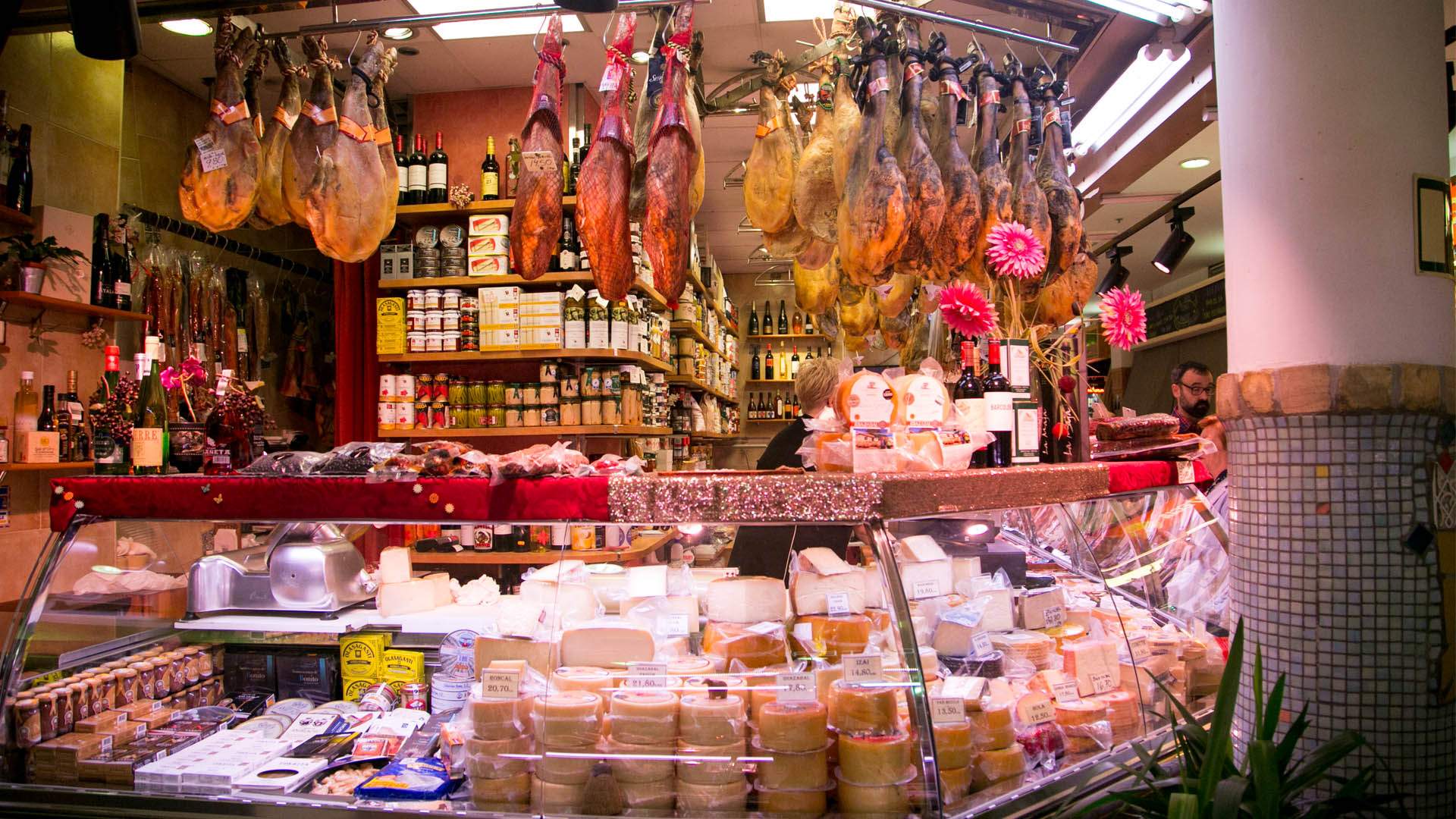A Foodie's Guide to Spain
From acorn-fed Iberian ham to cave cheese and green-tinted white wine — here's what to eat when you visit the motherland.
Spain has a diverse, complicated history which has percolated into its cuisine.Before Spain was the Spain we know today, the region was overtaken by Romans and later subdivided into tiny little kingdoms. These days there are still seventeen, fiercely independent, autonomous regions with their own culture, history and cuisine. To delve a little bit further into Spain's intriguing food scene and history, we boarded a Cathay Pacific flight to Barcelona to do a little bit of on the ground investigation with the help of Intrepid Travel.
![]()
ON THE WAY
Cathay Pacific's Pier Business Class lounge in Hong Kong offers the popular noodle bar and deli-style food hall where travellers can load up before their next leg on a variety of quick bites, including made-to-order dan dan and wonton noodles, dim sum, dumplings, salads, sandwiches, desserts, and other regional specials. The lounge also displays a teahouse with traditional Chinese and artisanal tea varieties.
In the air, the global airline celebrates its home city's renowned food culture with the 'Hong Kong Flavours' inflight dining menus. The concept, which celebrates the authentic tastes of Hong Kong, was introduced across all cabins on long-haul flights in 2018. Travellers can expect hyper-local dishes like braised abalone with flower shiitake and choy sum-layered bean curd, e fu noodle soup with crab meat sauce, coconut and red bean pudding, and baked seafood rice with tomato sauce.

LA RIOJA WINE
Spain has the most land under vine in the world, but in spite of that fact, it also has a comparatively low yield due to its arid climate Spain, making it only the world's third largest producer. Wine here has been grown since the Roman times, La Rioja (grown in the La Rioja region) being no exception. However, the oaky Rioja wine we all know today emerged in the 1860s when a vine root disease in Southern France pushed French winemakers into Spain to set up new vineyards there, bringing with them their particular winemaking techniques. Most wine from La Rioja is red and blended from mostly Tempranillo (meaning early harvest) and Garnacha grapes.
![]()
IBERIAN HAM
Pork is everywhere in Spain, marketplaces are packed with ham legs, tapas bars stocked with pork snacks and almost every traditional morsel we encountered featuring a type of pork. Pork's popularity in Spain has a lot to do with its deeply religious roots.
After the fall of Moorish Kingdom in Spain (from 1492 onwards), all Jews and Muslims were forced to either be killed, expelled from the country or to convert to Catholicism under Queen Isabel and King Ferdinand's Inquisition. Since eating pork was banned by both the Muslim and Jewish religions, eating pork or hanging ham legs outside one's shop became a way of flaunting and confirming one's Christianity. Pigs became an important element of Spanish Christian iconography, with images of pigs later incorporated into important Christian monuments such as the painted dome of the Romanesque Basilica of San Isidoro in Leon, in northern Spain. These days ham continues to be ridiculously popular with locals, the country producing a staggering 40 million hams a year.
The best Spanish pork is the the black hoofed ("pata negra") Iberian ham. These are acorn-fed, free range pigs (about two pigs wander each hectare of land) that are only slaughtered after reaching the required weight. Afterwards the legs are covered in Andalusian sea salt for a day per kilogram and then stored in a controlled environment until ready for sale. The entire process can take years. The Iberian ham, which can only be found in the Guijuelo, Huelva, Valle de los Pedroches and Extremadura regions, has a high, healthy fat content and is known for its distinctly strong but sweet flavour. It pairs nicely with a Rioja wine and sherry.
![]()
CABRALES CHEESE
At the foot of Picos de Europa National Park in Asturias, the under-hyped climbers and hikers' paradise, artisanal farmers make the blue-veined Cabrales cheese. The cheese is made from cow's milk during summer but blended with goat and sheep's milk in winter, which results in a slightly spicier cheese. The process is ridiculously simple, with the only ingredients being milk, rennet and salt. The rest of the work is all done by nature in various naturally occurring limestone caves where the cheese is stored between two to five months. Each cave's shape and temperature affecting the final product - caves with higher ceilings and lower temperatures creating more creamy, high end cheese but at a much slower rate.
To become a certified Cabrales cheese is no easy feat. Spaniards are fiercely protective of their cheeses – in order to be certified with a Protected Designation of Origin certification, Cabrales cheesemakers need to rigorously follow traditional, authentic means of production within the Asturias region. Cabrales blue cheese is distinctly sharper and more acidic than your regular blue cheese, pairing well with salami and fresh figs.
![]()
TXAKOLI WINE
The Basque country is a markedly distinct region of Spain, with its own language, its own weather and its own particular wine. Txatoli was a homemade wine until the 1980s, when some varieties achieved the Designation of Origin certification, which saw its popularity shoot up. The usually green-tinted, white wine is known for its acidic nature, low alcohol content and its extremely entertaining and rare pouring technique. Whenever it's served, txakoli is poured from a ridiculous height (over half a metre) by highly capable waiters and waitresses in order to aerate the wine and release the flavour. Txakoli-serving bar floors are usually lined with wood shavings to soak up any of the trainee waiters or eager-to-learn customer's attempts.
![]()
TAPAS
The word tapa is derived from the Spanish word 'tapar' which means to cover, but the origin story of the iconic national food's name is subject to artistic license. According to our Intrepid Travel tour guide's version of the tapas creation myth, there was a time in Spain when beer was cheaper than water and so people would get ridiculously drunk at night and not be able to work the following day. Along came King Alfonso XIII, who decided to make it illegal to sell an alcoholic beverage without some kind of food accompaniment. These snacks were served on top of the beverages, with the twofold purpose of cover the glass and protecting it from stray flies and dust, as well as covering the worst side-effects of the next day's hangover. (Other myths point to King Fernando XVIII as the genius behind the tapa's creation; others to some unsung hero in the countryside.)
![]()
PINCHOS
Pinchos literally translate as 'pinches' and are the name for little bar snacks 'pinched' together by a toothpick, a key feature which distinguishes them from your garden-variety tapas. A slice of bread is usually the base of the pincho. Back in the day, in a more trusting world, bar-goers would order as many small meals alongside their drinks as they'd like and at the end of the night go to the counter to have the quantity of their toothpicks counted to determine the bill. Pinchos are highly popular in the Cantabria, Asturias, Basque and Navarre regions of Spain where they are seen as a cornerstone to a good night out.
![]()
GETTING THERE
Cathay Pacific flies to Madrid five times a week and Barcelona four times a week via Hong Kong. A Northern Spain Real Food Adventure with Intrepid Travel starts at NZD3695 per person.

Images: Laetitia Laubscher, Cathay Pacific.












